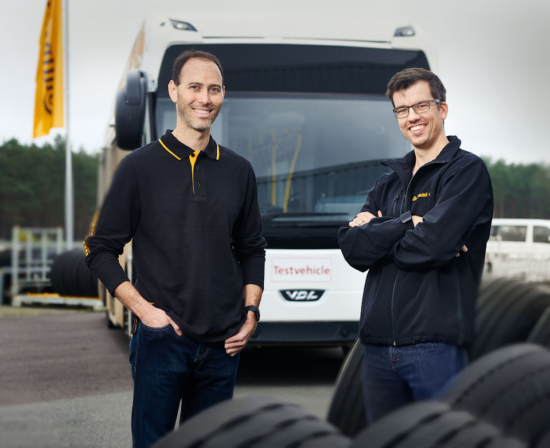Tyres for electric buses: Continental working to shorten development time
 Ben Hudson (l) & Michael Koch from Continental Truck Tires’ development department
Ben Hudson (l) & Michael Koch from Continental Truck Tires’ development department
Continental is currently testing prototype tyres for electric buses at its Contidrom proving ground in northern Germany. These prototypes, developed built by the tyre maker’s Prototyping department in Hanover-Stöcken and featuring hand-carved tread patterns, are the fruit of joint work with vehicle manufacturer VDL Bus & Coach. The partners’ aim is to reduce the time taken to complete the tyre development cycle, which currently takes three to five years from initial prototype to volume production.
As is the case with tyres for all types of electric vehicles, bus tyres are exposed to higher torque when moving off and accelerating. Yet Ben Hudson, automotive engineer at Continental Truck Tires, says he must consider further points when developing tyres for electric buses used in urban applications. “In downtown traffic in particular, vehicles need to run very quietly, so that the comfort offered by quiet electric drive isn’t diminished by loud road-tyre noise.”
Furthermore, the bus’s frequent deceleration in traffic is a key factor in the energy recovery or ‘recuperation’ process. Here, the electric motor acts as a generator and, driven by the bus’s deceleration, produces energy to charge the battery. This leads to a marked increase in the vehicle’s range. Compared to conventional brake management systems, this process of recuperation puts added strain on drive axle tyres.
Consequently, tyres for electric buses have to cope with tougher requirements than their counterparts that are fitted to buses with combustion engines. “At the same time, they need to deliver the same mileage and meet the same safety standards as bus tyres for conventional drive systems,” comments Hudson. The trade-offs between mileage, braking and handling performance, are technically demanding. “We are up against new requirements here, but obviously we’re not going to accept any compromises in terms of robustness or braking performance. Safety takes top priority for us.”
Freedom to try new concepts & ideas
As mentioned, Continental and VDL hope to reduce the development cycle time. Ben Hudson notes that the partners’ efforts are benefitting from a ‘clean sheet’ approach to the project – development work on the concept isn’t restricted by what has gone before in previous generations of tyres. “That gives us the freedom to try out entirely new concepts and ideas. If these prove successful, we’ll put them into practice very quickly and feed them into the development of the next line of tyres.”
This, he says, can lead to significantly shorter development cycles, meaning that Continental can react faster to market requirements. And in the search for the best possible solution, time is a key factor: Given the rapid pace of progress in the electric mobility segment, demand for suitable tyres is growing rapidly.


 Ateq
Ateq
Comments